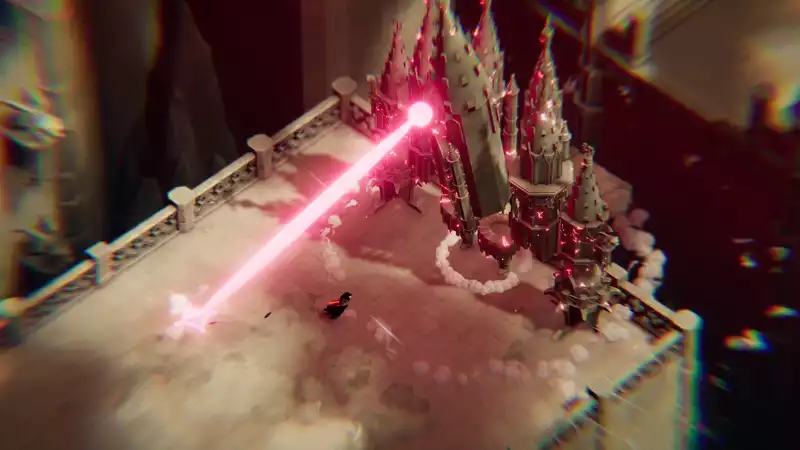Think of Death's Door as a parody of the world of Dark Souls. The stony gray ruins in the dying realm, the wandering oddballs who say scene-setting dialogue, the gothic style when you encounter a boss lounging in a keep. It's grim as hell, but kind of funny. The looming ruler has a novelty mug on his desk, the afterlife has been reimagined as a pencil-pushing bureaucracy, and the various reaper professional classes complain about the tedium of their work. Stepping into the sanctuary of the first boss, where there are neither dragons nor undead monsters but angry grannies, Death's Door has a less agitated ease that I've come to admire over the past 10 hours, and the two-person studio Acid Nerve, finds the sweet spot at every turn.
Death's Door is built like an old Zelda: players take control of a diminutive raven in a diorama-like world, equipped with swords and dreams, and traverse three dungeons to secure the Macufin needed to pry open the title gate. At each level, you will find an equipable weapon that will help you solve the puzzles in the labyrinth.
It's all very standard and predictable, as a good action adventure always is. I knew beyond a shadow of a doubt that a hookshot would appear when I saw the wooden stakes prominently strewn across the unreachable scaffolding, and I knew that the crumbling patch of wall would soon become an endless source of bombs. Anyone who grew up playing these types of games would be able to play "Death's Door" by instinct in their limbic system. [So you wipe out the catacombs, defeat the corresponding bosses, and blast through the short grand finale. If that seems lightweight, you're right. There are only four Zelda-like weapons to collect, and each is mapped directly to the D-pad as soon as you pick it up. There is a merchant in the hub world that offers an extremely lightweight option for building RPG characters. Essentially, players redeem all the souls they have accumulated from defeating enemies to enhance their attack power, dodging speed, shooting aptitude, etc. The dungeons themselves are slightly longer than the classic top-down spelunking of old, but not by much.
I spent most of my time at "Death's Door" expecting a surprise third act where the powers that be would demand a few more tokens scattered across the ends of the earth before seeing the credits. But it was not to be, and "Acid Nerve" resisted the pressure to water it down. What you see is what you get.
And to be honest, after the 150-hour quagmire of "Assassin's Creed" games and escalating boss fights by From Software devotees, I was delighted by the simplicity of "Death's Door". It subverts the action-adventure genre to its very core. Every obstacle can be solved by logical deduction or memorization of patterns. You are not asked to master a dozen custom-made animations of swords and blows, nor do you have to hunt down cryptic portals and their keys to poke around each zone (as in Dark Souls' "The Painted World of Ariamis"). The music is primarily a gorgeous piano refrain, and the more you immerse yourself in Death's Door's rhythms, the more hypnotic the effect becomes. There is real magic in a game that is only as long as it takes to get to the point.
"Death's Door" can be a difficult game, and in some of the later sections, entire armies are thrown at your little raven's path. However, attacks and evasions can be chained together in a flowing fashion, and no matter how many times I restarted the game, it never felt particularly cheesy. A little more flair on top of the standard roll-and-slash combat wouldn't have hurt, but the system works. In fact, I was surprised that "Death's Door" was as violent as it was. Each time the steel makes contact with the flesh, the Acid Nerve shakes the controller, and the fools fall to the ground, gurgling like professional wrestlers. No one has the privilege of dying in a puff of smoke.
That sublimity is only hindered by a few problems. Death's Door does not at all match the perfect level design that Nintendo's brainchild has been defending. In other words, I spent a couple of sections trying to find the last key that unlocks the next encounters, and having to walk back and forth down the hallway over and over again. Death's Door is good because it provides a decent checkpoint, but there's nothing to stop you from walking right past the enemies you beat in the previous dungeon, which makes the corpse run a bit pointless. Punish them with a grind or let them respawn where they died. Promises.
Otherwise, "Death's Door" feels like a micro-epic. It's as if an epic entry in the overarching canon, quirky, humorous, and filled with astounding attention to detail, has been miraculously miniaturized to fit into a two-week lunch break. Perhaps the great stories of video games don't need to be scattered across huge level caps and supersized open worlds. Perhaps all that is needed is a transcendent atmosphere.
.

Comments